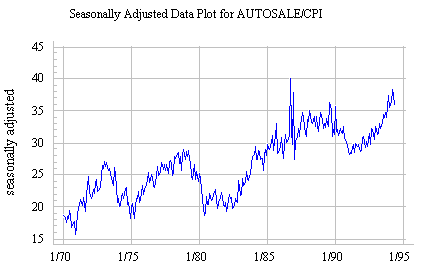

Multiplicative adjustment
Additive adjustment
Acronyms: SA, NSA, SAAR
Multiplicative adjustment: The increasing amplitude of seasonal variations observed in the retail auto sales series is suggestive of a multiplicative seasonal pattern: the seasonal effect expresses itself in percentage terms, so the absolute magnitude of the seasonal variations increases as the series grows over time. Such a pattern can be removed by multiplicative seasonal adjustment, which is accomplished by dividing each value of the time series by a seasonal index (a number in the vicinity of 1.0) that represents the percentage of normal typically observed in that season.
For example, if December's sales are typically 130% of the 12-month-average monthly value (based on historical data), then each December's sales would be seasonally adjusted by dividing by 1.3. Similarly, if January's sales are typically only 90% of average, then each January's sales would be seasonally adjusted by dividing by 0.9. Thus, December's value would be adjusted downward while January's would be adjusted upward, correcting for the anticipated seasonal effect. Depending on how they were estimated from the data, the seasonal indices might remain the same from one year to the next, or they might vary slowly with time.
The seasonal indices computed
by the Seasonal Decomposition procedure
in Statgraphics are constant over time, and are computed via the
so-called "ratio-to-moving average method." (For an
explanation of this method, see the notes on spreadsheet
implementation of seasonal adjustment
from lecture 4.)
More specialized software for time series analysis may offer some
version of the X11
or X12 methods developed by the U.S. Census Bureau, which estimate
time-varying seasonal indices. The latter methods are used to
seasonally adjust most data published by government bureaus.
Here are the multiplicative seasonal indices for AUTOSALE as computed by the Seasonal Decomposition procedure in Statgraphics:

Now here is the seasonally adjusted version of AUTOSALE that is obtained by dividing each month's sales value by its estimated seasonal index:

Notice that the pronounced seasonal pattern is gone, and what remains are the trend and cyclical components of the data, plus random noise.
Additive adjustment: As an alternative to multiplicative seasonal adjustment, it is also possible to perform additive seasonal adjustment. A time series whose seasonal variations are roughly constant in magnitude, independent of the current average level of the series, would be a candidate for additive seasonal adjustment. In additive seasonal adjustment, each value of a time series is adjusted by adding or subtracting a quantity that represents the absolute amount by which the value in that season of the year tends to be below or above normal, as estimated from past data.
Additive seasonal patterns are somewhat rare in nature, but a series that has a natural multiplicative seasonal pattern is converted to one with an additive seasonal pattern by applying a logarithm transformation. Therefore, if you are using seasonal adjustment in conjunction with a logarithm transformation, you should specify additive rather than multiplicative seasonal adjustment. (In the Seasonal Decomposition and Forecasting procedures in Statgraphics, you are given a choice between additive and multiplicative seasonal adjustment.) (Return to top of page.)
Acronyms: When examining the descriptions of time series in Economagic and other sources, the acronym SA stands for "seasonally adjusted, whereas NSA stands for "not seasonally adjusted. A seasonally adjusted annual rate (SAAR) is a time series in which each period's value has been adjusted for seasonality and then multiplied by the number of periods in a year, as though the same value had been obtained in every period for a whole year. (Return to top of page.)